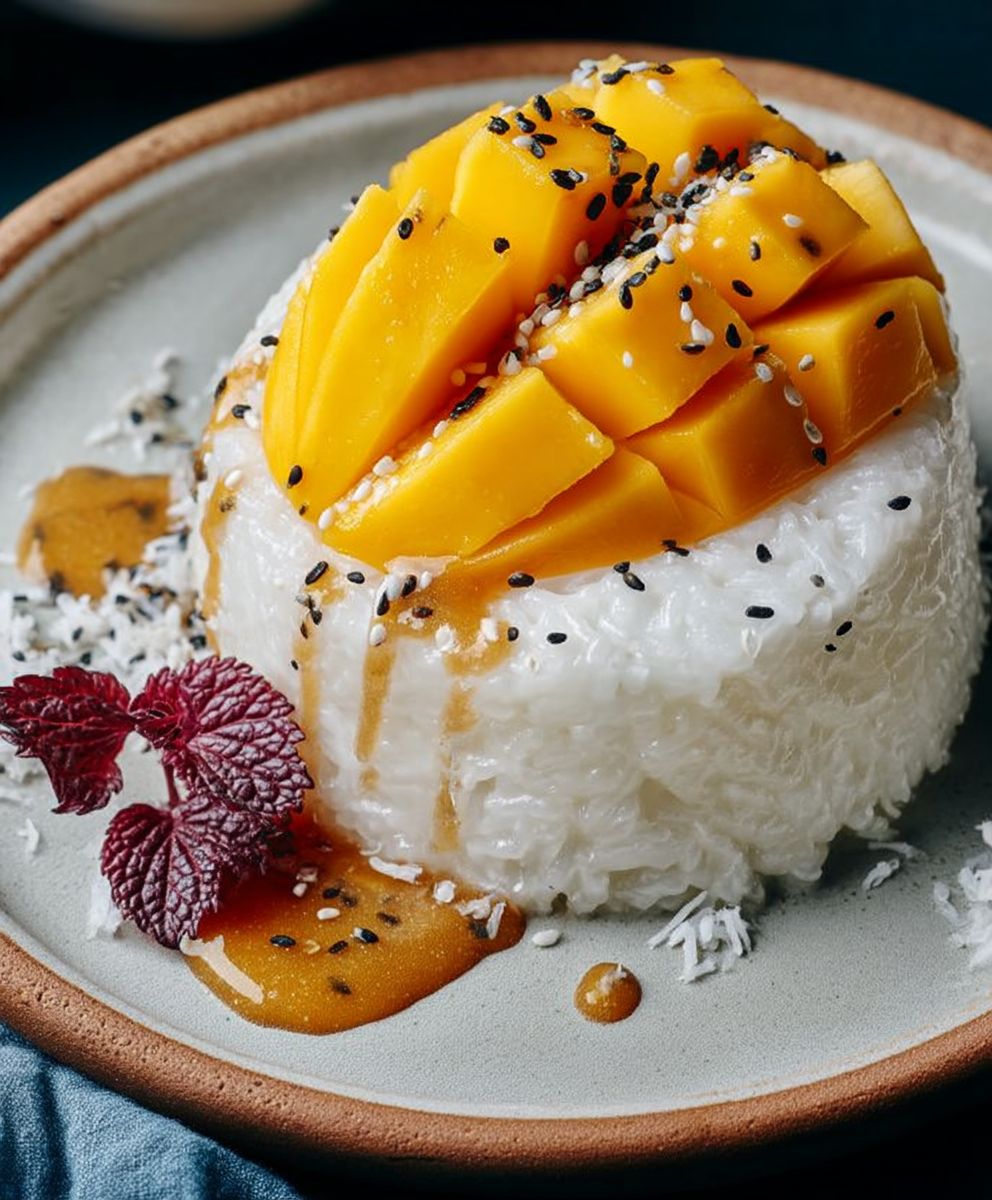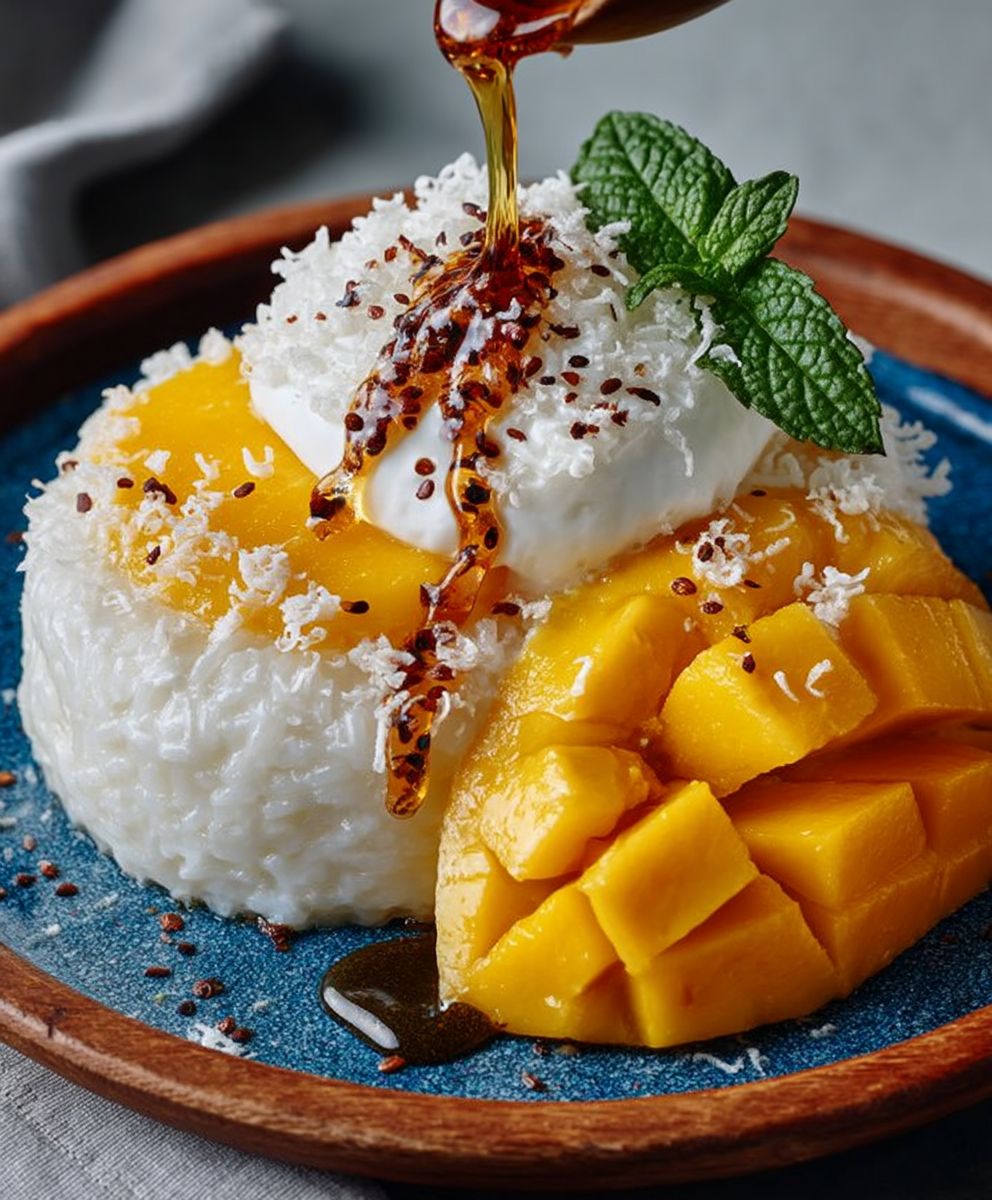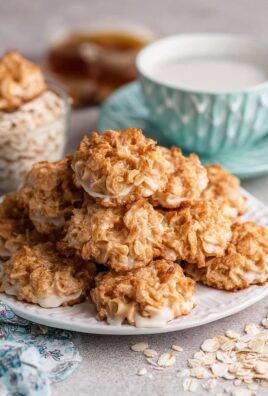Mango Sticky Rice: just the name conjures up images of sun-drenched beaches, vibrant markets, and the sweet, comforting aroma of coconut milk. Have you ever tasted something so divine that it instantly transports you to another place? For me, that’s exactly what this classic Thai dessert does. It’s more than just a dish; it’s an experience, a little bite of Southeast Asian paradise.
This delightful treat, known as “Khao Niao Mamuang” in Thailand, has a rich history deeply intertwined with Thai culture. Traditionally enjoyed during mango season, it’s often served at special occasions and festivals, symbolizing prosperity and good fortune. The combination of sticky rice, perfectly ripe mangoes, and creamy coconut milk is a testament to the simple yet exquisite flavors of Thai cuisine.
But what makes Mango Sticky Rice so universally loved? It’s the harmonious blend of textures and tastes. The glutinous rice, steamed to perfection, offers a satisfying chewiness, while the juicy, sweet mango provides a burst of tropical flavor. The rich, slightly salty coconut milk drizzled over the top ties everything together, creating a symphony of sensations in your mouth. Plus, it’s relatively easy to make at home, making it a perfect treat for a weeknight dessert or a special weekend indulgence. Get ready to embark on a culinary adventure as we explore how to create this authentic and irresistible dessert in your own kitchen!
Ingredients:
- For the Sticky Rice:
- 1 ½ cups glutinous rice (sweet rice), also known as sticky rice
- 1 ½ cups water, for soaking
- 1 can (13.5 oz) full-fat coconut milk
- ½ teaspoon salt
- 2 tablespoons granulated sugar
- For the Mango Sauce:
- ½ can (6.75 oz) full-fat coconut milk
- ¼ teaspoon salt
- 1 tablespoon granulated sugar
- 1 teaspoon cornstarch, mixed with 1 tablespoon cold water (slurry)
- For Serving:
- 2 ripe mangoes, peeled and sliced
- Toasted sesame seeds (optional)
Preparing the Sticky Rice:
- Soaking the Rice: The first, and arguably most important, step is to properly soak the glutinous rice. This allows the grains to absorb moisture and cook evenly. Place the glutinous rice in a large bowl. Add 1 ½ cups of water, ensuring the rice is fully submerged. Let it soak for at least 4 hours, or preferably overnight, in the refrigerator. This long soaking time is crucial for achieving that perfect, sticky texture. I usually prepare this the night before so it’s ready to go in the morning.
- Draining the Rice: After soaking, drain the rice thoroughly using a fine-mesh sieve. Rinse it under cold running water until the water runs clear. This removes excess starch and helps prevent the rice from becoming overly gummy during cooking. Make sure you get all the water out!
Cooking the Sticky Rice:
There are a few ways to cook the sticky rice. I’ll outline my preferred method using a steamer, as it yields the most consistent and authentic results. You can also use a rice cooker, but the texture might be slightly different.
- Steaming the Rice: Line a steamer basket with cheesecloth or parchment paper, leaving some overhang to prevent the rice from falling through. This also makes cleanup much easier. Spread the drained rice evenly over the prepared steamer basket.
- Steaming Time: Fill the bottom of your steamer with water, ensuring the water level is below the steamer basket. Bring the water to a boil over medium-high heat. Once boiling, carefully place the steamer basket with the rice over the boiling water. Cover the steamer tightly with a lid. Steam the rice for 20-25 minutes, or until the rice is translucent and tender. Check the water level periodically and add more if needed. The steaming time can vary depending on your steamer and the type of rice, so keep an eye on it.
- Checking for Doneness: To check if the rice is done, take a small sample and taste it. It should be soft, slightly chewy, and not crunchy. If it’s still too firm, continue steaming for another 5-10 minutes, checking periodically.
Preparing the Coconut Milk Mixture:
- Combining Ingredients: While the rice is steaming, prepare the coconut milk mixture. In a medium saucepan, combine the can of coconut milk (13.5 oz), salt, and sugar. Stir well to dissolve the sugar and salt.
- Heating the Mixture: Place the saucepan over medium heat. Bring the mixture to a gentle simmer, stirring occasionally to prevent scorching. Do not let it boil.
- Infusing the Rice: Once the rice is cooked, carefully transfer it to a large bowl. Pour the warm coconut milk mixture over the hot rice. Gently fold the rice and coconut milk together, ensuring all the rice is evenly coated. Be careful not to mash the rice.
- Resting Time: Cover the bowl with plastic wrap or a clean kitchen towel. Let the rice rest for at least 30 minutes, or up to an hour, allowing the rice to absorb the coconut milk. This step is crucial for achieving that creamy, flavorful sticky rice. The longer it rests, the better it will taste!
Making the Mango Sauce:
- Combining Ingredients: While the rice is resting, prepare the mango sauce. In a small saucepan, combine the remaining coconut milk (6.75 oz), salt, and sugar. Stir well to dissolve the sugar and salt.
- Creating the Cornstarch Slurry: In a separate small bowl, whisk together the cornstarch and cold water until smooth. This slurry will help thicken the sauce.
- Heating and Thickening: Place the saucepan with the coconut milk mixture over medium heat. Bring the mixture to a gentle simmer, stirring occasionally. Once simmering, slowly pour in the cornstarch slurry, whisking constantly to prevent lumps from forming.
- Simmering the Sauce: Continue to simmer the sauce for 1-2 minutes, or until it thickens slightly. The sauce should be thick enough to coat the back of a spoon. Remove from heat and set aside.
Assembling and Serving:
- Preparing the Mangoes: While the rice is resting and the sauce is cooling slightly, prepare the mangoes. Peel the mangoes and slice the flesh into thin, even slices. I like to use the “hedgehog” method, where you score the mango flesh in a grid pattern and then invert the skin to create a beautiful presentation.
- Plating: To serve, scoop a generous portion of the sticky rice onto a plate. Arrange the mango slices alongside the rice. Drizzle the warm mango sauce over the rice and mangoes.
- Garnishing (Optional): Sprinkle toasted sesame seeds over the top for added flavor and texture. You can also add a sprig of mint for a pop of color.
- Enjoy! Serve immediately and enjoy your homemade Mango Sticky Rice! This dessert is best enjoyed warm or at room temperature. The combination of the sweet, sticky rice, the creamy coconut milk, and the juicy mangoes is simply irresistible.
Conclusion:
And there you have it! I truly believe this Mango Sticky Rice recipe is an absolute must-try, and here’s why: it’s a symphony of textures and flavors that dance on your palate. The creamy, sweet coconut milk perfectly complements the slightly tangy, juicy mango, all nestled on a bed of perfectly cooked, subtly sweet sticky rice. It’s a dessert that’s both comforting and exotic, simple to make yet incredibly satisfying. Trust me, once you try this, you’ll be hooked!
But the beauty of this recipe lies not only in its simplicity but also in its versatility. While the classic combination of sweet sticky rice, ripe mango, and coconut milk is divine, there are so many ways to personalize it and make it your own.
Serving Suggestions and Variations:
* Grilled Mango: For a smoky twist, try grilling your mango slices before serving. The caramelization adds a whole new dimension of flavor.
* Toasted Sesame Seeds: A sprinkle of toasted sesame seeds adds a delightful nutty crunch and visual appeal. Black sesame seeds offer a particularly striking contrast.
* Pandan Infusion: Infuse your coconut milk with pandan leaves for an extra layer of fragrant complexity. Simply simmer the coconut milk with a few pandan leaves for about 10-15 minutes, then remove the leaves before using.
* Different Mango Varieties: Experiment with different types of mangoes! Each variety has its own unique sweetness and texture, so have fun finding your favorite. Honey mangoes, Alphonso mangoes, or even Ataulfo mangoes would all be delicious.
* Coconut Flakes: Add some toasted coconut flakes for extra texture and coconut flavor.
* A Pinch of Salt: Don’t underestimate the power of a tiny pinch of salt! A little salt in the coconut milk can actually enhance the sweetness and balance the flavors.
* Make it Vegan: Ensure your coconut milk is plant-based and you’ve got a delicious vegan dessert!
* Warm vs. Cold: While traditionally served warm, Mango Sticky Rice is also delicious chilled, especially on a hot day. Try it both ways and see which you prefer!
* Add a scoop of coconut ice cream: For an extra decadent treat, add a scoop of coconut ice cream on top.
I’ve poured my heart into perfecting this recipe, and I’m confident that you’ll love it as much as I do. It’s perfect for a special occasion, a simple weeknight treat, or even a potluck contribution that’s sure to impress.
So, what are you waiting for? Gather your ingredients, put on some music, and get ready to embark on a culinary adventure. I promise, the aroma of the sweet rice cooking and the anticipation of that first bite will be well worth the effort.
I’m so excited for you to try this Mango Sticky Rice recipe! Once you’ve made it, please, please, please come back and share your experience in the comments below. I’d love to hear what you thought, what variations you tried, and any tips or tricks you discovered along the way. Your feedback is invaluable, and it helps me continue to improve and share even more delicious recipes with you all. Happy cooking, and enjoy every single bite! I can’t wait to hear from you!
Mango Sticky Rice: The Ultimate Guide to Thailand's Sweet Treat
Sweet glutinous rice steamed to perfection, infused with creamy coconut milk, and served with fresh, juicy mangoes and a luscious mango sauce.
Ingredients
Instructions
Recipe Notes
- Soaking the rice overnight is highly recommended for the best texture.
- Use full-fat coconut milk for the richest flavor.
- Be careful not to overcook the rice; it should be soft and slightly chewy.
- Letting the rice rest after infusing with coconut milk is crucial for achieving the desired creaminess.
- The mango sauce should be thick enough to coat the back of a spoon.
- Serve warm or at room temperature.







Leave a Comment